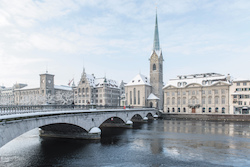Speaker
Mr
Jialu Chen
(Institute of Low Temperature Science, Hokkaido University)
Description
Surface melting of ice occurs below 0°C, and then ice surfaces are covered with quasi-liquid layers (QLLs). Our previous studies revealed that QLLs are formed kinetically on ice single crystals only in the temperature range higher than -2°C [1, 2]. However, other studies reported the appearances of QLLs even below -10°C [3]. To clarify the cause for this big discrepancy, in this study we focused on polycrystalline ice that includes a large amount of lattice defects and grain boundaries, and aimed to find the difference in the emergence of QLLs on poly- and single crystalline ice.
A thin film of polycrystalline ice with the size smaller than 0.5×0.5 mm^2 was prepared on a glass plate. Then the glass plate with the ice thin film was placed in an observation chamber, in which temperature of the ice thin film (T) and water vapor pressure (P) can be controlled separately. First, QLLs were formed on the polycrystalline ice thin film under a P-T range (P: supersaturated and T>-2°C), in which QLLs are formed spontaneously on an ice single crystal. Second, T was decreased to a certain T (<-2°C), and then at this constant T, P was decreased gradually. Throughout these processes, the surface of the polycrystalline ice thin film was observed by two kinds of optical microcopy: bright-field optical microscopy and Michelson-type interferometry. These two kinds of microscopy were combined with laser confocal microscopy.
When QLLs were formed on the polycrystalline ice thin film at T>-2°C, we could observe the QLLs, by bright-field microscopy, as objects with a dark contrast, which corresponded to the contrast formed by the interference between light beams reflected at an air-QLL interface and a QLL-ice interface. The QLLs with the dark contrast showed significant fluidity, clearly demonstrating that they were not solid but liquid.
After T was decreased to a certain T (<-2°C), we observed the QLLs by Michelson interferometry. On the QLLs, we could observe interference fringes formed by the interference between light beams reflected at the air-QLL interface and a reference mirror. From the moving direction of these interference fringes, we found that after the decrease in T, QLLs were growing. Then at the constant T, we gradually decreased P. When P became smaller than a certain critical value, the interference fringes were moved in the opposite direction, indicating that the QLLs started to shrink. The critical P shows the pressure above which the QLLs could grow stably.
We performed similar experiments under various temperatures. Then we found that on polycrystalline ice, QLLs can exist stably at least in the temperature range of -15 to 0 °C, which is significantly lower than that on single crystalline one.
References
1) H. Asakawa, et al., PNAS, 113, 1749-1753 (2016).
2) K. Murata, et al., PNAS, 113, E6741-E6748 (2016).
3) M. Elbaum, et al., J. Cryst. Growth, 129, 491-505 (1993).
Significance statement
We directly visualized the growth and shrinkage of quasi-liquid layers (QLLs) on polycrystalline ice by bright-field optical microscopy and Michelson-type interferometry. Then we experimentally proved that QLLs can appear on polycrystalline ice at a much lower temperature range than that on single crystalline one.
Author
Mr
Jialu Chen
(Institute of Low Temperature Science, Hokkaido University)
Co-authors
Prof.
Gen Sazaki
(Institute of Low Temperature Science, Hokkaido University)
Dr
Ken Nagashima
(Institute of Low Temperature Science, Hokkaido University, Japan)
Dr
Ken-ichiro Murata
(Institute of Low Temperature Science, Hokkaido University)

